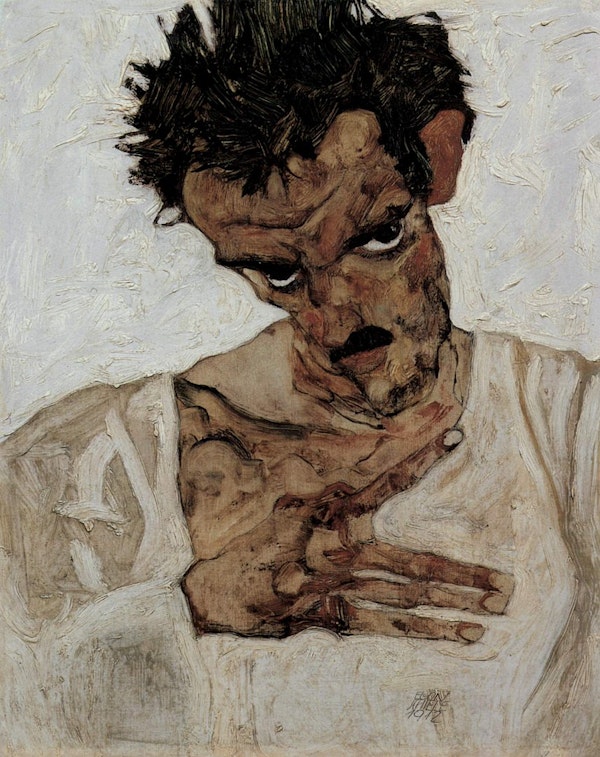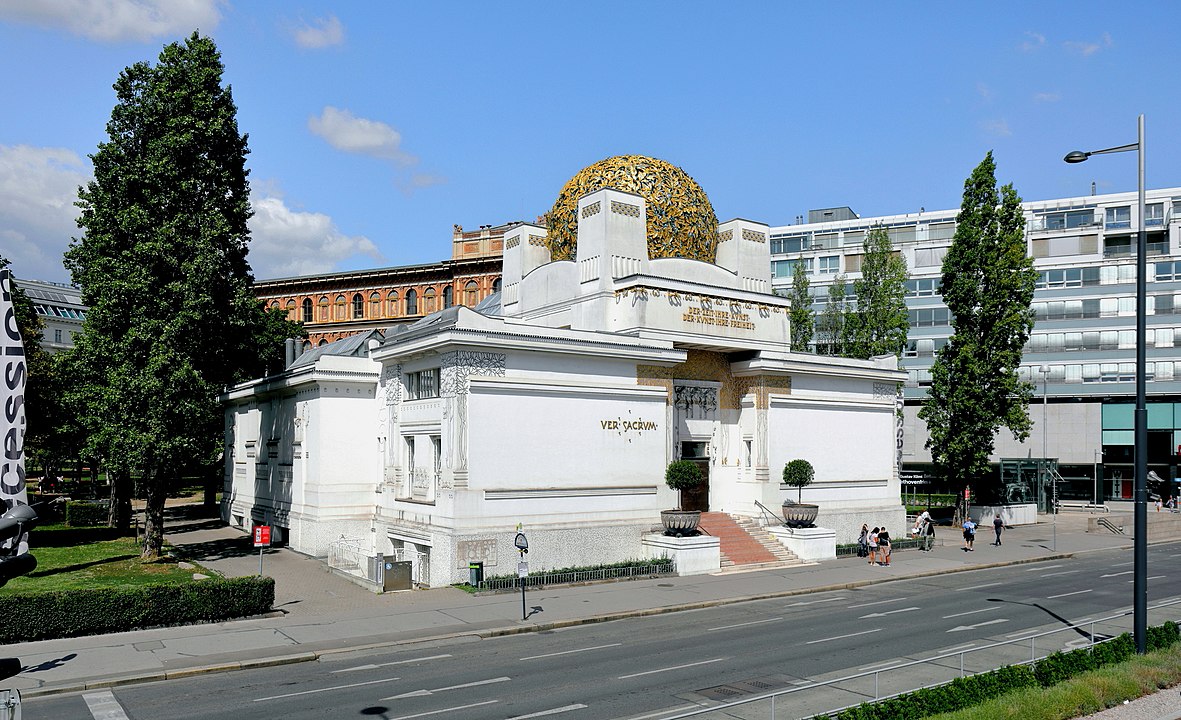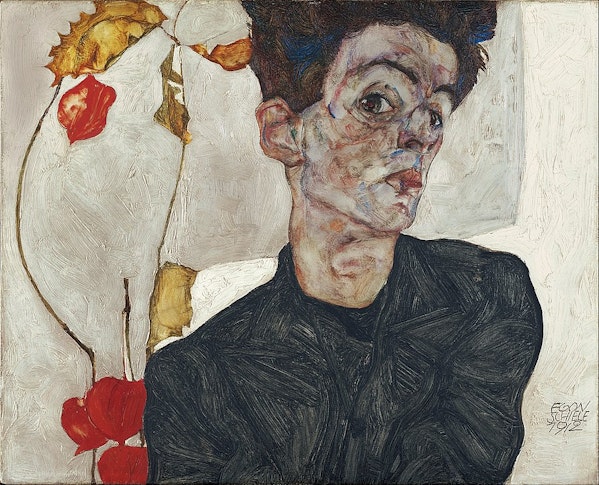
EgonSchiele|Self-portrait with his head down, 1912
What is the Vienna Secession?
💡A group that emerged at the end of the 19th century as a rebellion against the conservatism of Viennese art
💡Collected symbolist and expressionist artists
💡Many artists have a strong sense of originality
Overview of the Vienna Secession
The Vienna Secession was founded in 1897 in Vienna by the painter Gustav Klimt The term "Vienna Secession" refers to a group of emerging artists formed in Vienna in 1897 around the painter Gustav Klimt.
Its official name is the "Austrian Society of Plastic Artists.
The term "Secession" in the name of the art movement refers to the consciousness of German-speaking artists in the 19th century who sought to separate themselves from historical painting and traditional art.
Klimt and others are famous for their highly decorative compositions, which have something in common with the French Art Nouveau (New Art) movement that took place around the same time.
.jpg?w=400&h=814)
Gustav Klimt, Judith with Holofernes' Head, 1901
Leading Members of the Secession
The target of the Secession artists' rebellion was the Kunstlerhaus, an academic artists' organization.
Although the art world in Vienna at that time was conservative, with little influence from Impressionism, a group of innovative young artists known as the "Club of Seven" had nevertheless emerged. There were, Josef Maria Olbrich and Josef Hoffmann and Koloman Moser and others.
Olbrich, architect of the Secession Hall
Josef Maria Olbrich is known for building the Secession Hall (completed in 1898), a venue for exhibiting Secessionist works.
In 1899, she was invited by Ernst Ludwig, Grand Duke of Hesse, the state in which Frankfurt is located, to design the "Matilda's Hill," an artists' village in Darmstadt, as the general director.
The opening ceremony of the artist village was held in 1901, and the first exhibition was held there.
Artists' houses and exhibition halls were built in the village, most of which were designed by Olbrich.

Joseph Maria Olbrich, "Secession Hall," 1898
(2) Josef Hoffmann, father of the Wiener Werkstätte
Born in the Czech Republic, Hoffmann studied at the Czech National School of Crafts before working at a military installation in Würzburg, Germany.
He then moved to Austria and resumed his studies at the Academy of Fine Arts in Vienna. There, he studied under Otto Wagner, one of the leading architects of modern architecture.
At the Academy, he participated in the launch of the Vienna Secession with Olbrich (1897) and designed the interior of the Secession Hall, but left as early as 1905.
.jpg?w=600&h=461)
Installation by Josef Hoffmann of the Beethoven Frieze by Gustav Klimt in the Secession Building (1902)
(3) The all-around brilliant Koloman Moser
Moser, who was also involved in the launch of the Secession School, made full use of the diversity of his talents in a variety of fields, including painting, interior design, furniture, stained glass, bookbinding, posters, and fashion design.
He was also involved in the establishment of the Wiener Werkstätte with the above-mentioned Hoffmann, but left the Werkstätte after about four years.
His designs and other works repeatedly use simple lines and motifs similar to those found in ancient Greek and Roman architecture, returning from the decadent art of the past to an art that more ideally reflects the beauty of antiquity.

Blumenstock und Keramikkrug, 1912
4) Egon Schiele, who painted intense portraits.
Egon Schiele also recently had a major retrospective exhibition in Japan. Egon Schiele who recently had a large retrospective exhibition in Japan, joined the Secession after leaving Klimt's school.
Schiele showed precocious talent from an early age, entering the Vienna School of Crafts (where Klimt also studied as a senior student) at the age of 16.
While the school was more of a craftsman's training, Schiele continued his studies at the Academy of Fine Arts, where he pursued pure art.
Some of Schiele's paintings explicitly depicted death, sexuality, and other ethically repugnant themes, which was very shocking to the public at the time. He admired Van Gogh's "Sunflowers" and sharpened his expressionist style.
Schiele's path to public understanding took many twists and turns, including being evicted from his village after his neighbors smoked him out for painting prostitutes as nude models, and having a large number of "indecent" drawings seized from his studio when he was detained by the police for spending the night with a 14-year-old girl. He also served in the army.
After a period of military service, Schiele achieved exceptional success as a painter, but this success was short-lived as he died prematurely at the age of 28. He died of the Spanish flu that was sweeping Europe at the time.
Schiele's paintings are still popular to this day for their intense originality, and are said to fetch billions of yen at some auctions.
He is an artist who still has a strong influence on contemporary artists.

Egon Schiele, Self-Portrait with Hozuki (1912), Collection of the Leopold Museum
Obstacles in the Formation of the Secession
The Society of Plastic Artists was founded with Gustav Klimt as its president, but the Kunstlerhaus, the authority on art, refused to recognize it.
As a result, Klimt and other members who had already joined the Kunstlerhaus withdrew.
In 1898, the first exhibition of the Vienna Secession was held.
It is said that Emperor Franz Joseph I personally visited the opening ceremony, indicating the high level of public interest.
The first issue of the journal "Ver Sacrum" (Latin for "Sacred Spring"), published in the same year, contained the following philosophy
We no longer know the difference between "great art" and "small art. We no longer know the difference between art for the rich and art for the poor. Art is wealth for the public.
By having its own exhibition facility and holding its own exhibitions, the Vienna Secession may be said to have given itself an authority that went beyond mere rebellion against an entire era.
The gilded dome of the Secession Hall, with its openworked laurel leaf motif, was nicknamed "the yellow onion" by the Viennese at the time. The Viennese called it "The Yellow Onion" at that time.
References
See the latest works of TRiCERA ART
TRiCERA ART members enjoy a wide range of privileges and preferences.
- Discounts, including members-only secret sales and coupons
- Create your own collection by registering your favorite artists
- Receive updates on popular artists, exhibitions, and events
- Receive a weekly newsletter with selected art
- Personal Assessment to find out what kind of art you like.
Please register as a member for free and receive the latest information.
Free Member Registration